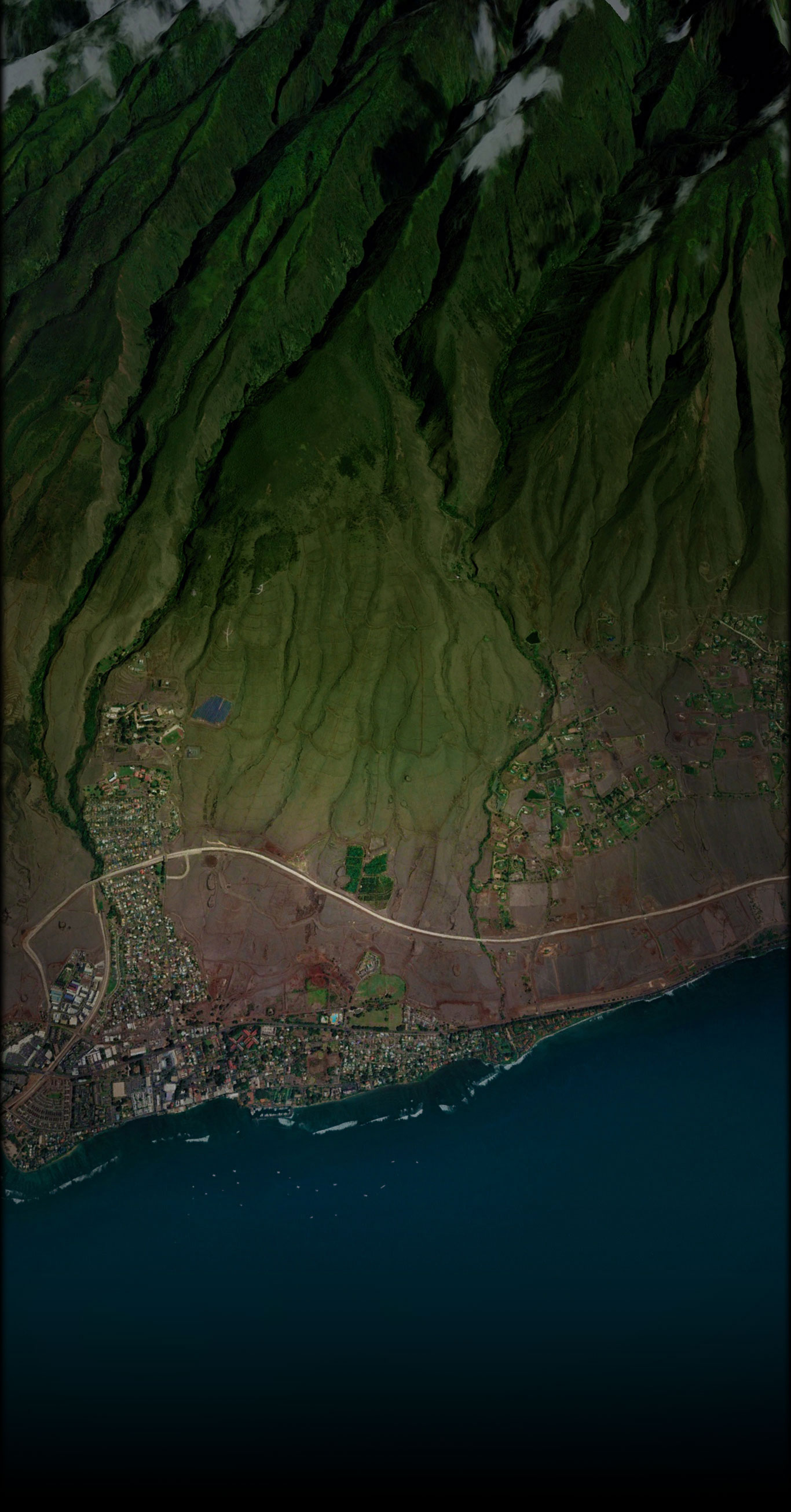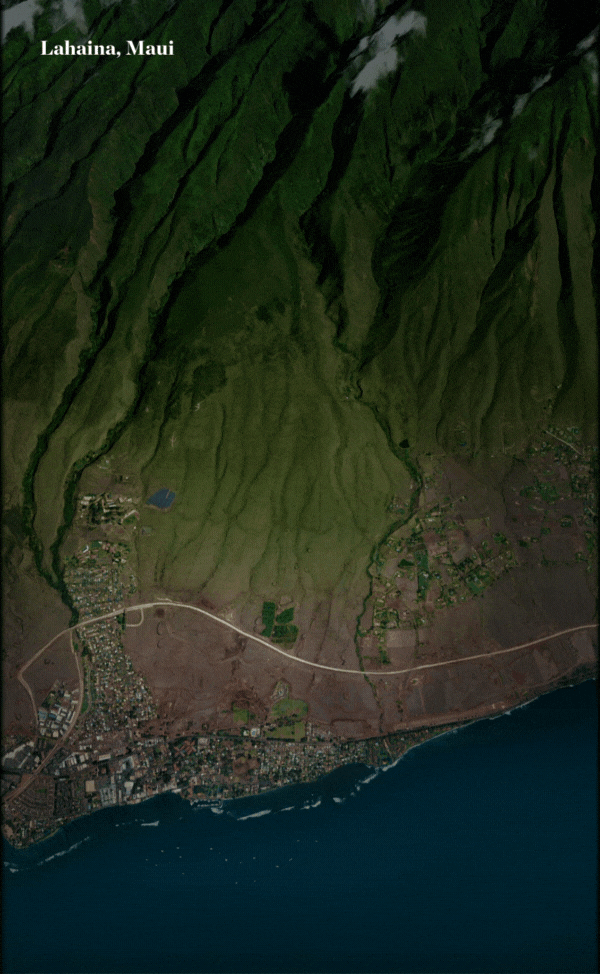





As an ‘ōiwi educational organization, this famous poetic reference to Lahaina holds special meaning. We are reminded of lessons shared across the generations, ‘ike kūpuna (ancestral knowledge and practices) and the success of our kūpuna. We honor the wisdom of our forebears as we steward ‘Āina Pauahi, the legacy lands of Ke Ali‘i Bernice Pauahi Bishop. Our founder inherited nearly 2,500 acres in Ku‘ia and Paunau, located in the moku of Lahaina, from the ali‘i Ruth Ke‘elikōlani, Victoria Kamāmalu and Mō‘ī William Lunalilo.
We are working closely with Lahaina ‘ōiwi leaders, government, and private and public partners to bring abundance back to Lahaina. We are leading this effort with a holistic approach to stewardship in Lahaina, utilizing an ahupua‘a perspective, managing from the mountains to the sea.
We hope to contribute to a more resilient community, where revitalized lands and waters sustain and nurture generations to come. To achieve this, we are committed to helping survivors, amplifying community initiatives, and managing our ‘āina through culturally rooted stewardship. We are dedicated to Lahaina’s recovery, and we look to the area’s vibrant past as the foundation for its future.
“If we’re gonna rebuild this town, we gotta do um right.”

Our ma uka restoration aims to better connect Lahaina to the life-giving waters of Pu‘u Kukui – one of the wettest places on the planet. Our hope is to revive the abundance that led a 19th century Native Hawaiian historian to call Lahaina, “he mahina ‘ai no ka Mokupuni ‘o Maui” (the food garden for the island of Maui) and brought Queen Lili‘uokalani to reference lush beds of palapalai ferns in mele inspired by the time she spent there. The plan to restore the natural ecosystem of this upper area will extend the tree line from the upland rainforests into the lower elevations, to create groundcover, retain moisture in the soil and cool the ‘āina. The rejuvenated native ecosystem will reconnect the community to these lands, by creating opportunities for education, as well as cultural practices and experiences.
“How our ancestors saw this place, and how they sustained themselves for thousands of years, those are now the solutions to our problems today.”
Efforts to restore Lahaina’s native ecosystem are underway with removing invasive eucalyptus trees, installing conservation fencing and replanting native species.

On the mid-elevation lands, KS envisions the re-emergence of Ka Malu ‘Ulu o Lele, the renowned canopy of food trees that historically nourished Lahaina. We will work with the tenants and community partners to re-establish and expand agricultural areas, encouraging more food cultivation and greater food sustainability for Maui. The upper portion of this zone will integrate food and other trees with pasturing. Our goal is to return groves of kumulā‘au that were once a staple of Lahaina, possibly featuring trees such as ‘ulu, mango, kukui and avocado. Alongside this agroforestry, we want to raise livestock for food production and to limit the growth of non-native grasses. The lower portion will feature diversified agriculture and accommodate community plans for a memorial and educational opportunities. We hope it will be a place that supports both food abundance and community abundance.
“Take a look at some of the new pulapula, the resiliency of our ‘ulu. The fact that they are still going, still strong … Let that be a testament of the will of our people and the strength of our ‘āina.”
This summer, Ke Kula ‘o Kamehameha Maui alumni came together in Ku‘ia to put native plants in the ground and strengthen their roots in ‘āina and community.

Our goal for our Ku‘ia lands ma kai of the Lahaina Bypass is to help Lahaina’s recovery. We are committed to a collaborative approach that rebuilds a vibrant town with the appropriate mix of land uses to meet the needs of the community. These lands could include a school or other educational facilities, open space, areas for ecosystem restoration and cultural practices, parks, commercial and community centers, and housing for Lahaina residents. We are currently in conversations with community members, stakeholders, government officials, and many others to explore what rebuilding Lahaina the right way could look like.
“Lahaina can become the example on how we move forward for Hawai‘i.”
Kamehameha Schools’ lands in Ku‘ia will be the home of the new King Kamehameha III Elementary School, marking a significant milestone in Lahaina’s restoration. The State of Hawai‘i, the Department of Education (HIDOE), and County of Maui announced the selection of the site at an online community meeting on Oct. 1.

Our effort to mālama wai throughout the ahupua‘a connects us to one of the Lahaina community’s highest priorities of restoring the wahi pana of Moku‘ula and Mokuhinia. As Lahaina’s largest spring and stream-fed fishpond, Mokuhinia encircled the sacred islet of Moku‘ula, a seat of immense political and spiritual power where ruling ali‘i from Pi‘ilani to Kamehameha III made their home. When Lahaina served as the capital of the Hawaiian Kingdom, its fertile lands were covered with ‘ulu, kalo, niu and many other crops that nourished and sustained communities. The sugar industry’s diversion of water eventually resulted in the cultural landmark being covered up. Our hope is that the return of wai to the former wetland will help restore the heart of Lahaina, bringing abundance to all its people.
“If Moku‘ula get water, every place get water. And that means we’re in the right direction.”
* Quotes from Lahaina leaders are included to illustrate the community-based inspiration helping to guide Kamehameha Schools’ stewardship approach to ‘āina in West Maui. Their voices matter to us, but the inclusion of these leaders’ mana‘o is not meant to suggest they have endorsed these specific proposals.